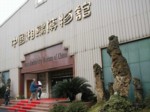
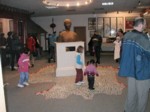
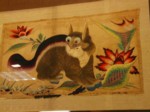
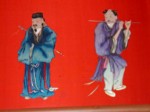
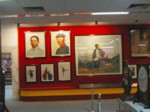
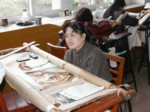
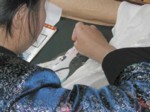
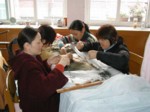
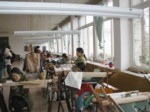
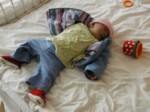
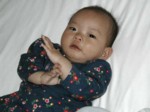
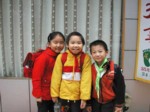
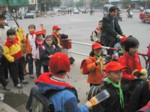
Today we’re visiting the Changsha Social Welfare Institute #1, which is a state-run combination nursing home and orphanage. Four of the babies in our group were adopted from this orphanage, but not Hope. She comes from the Yueyang City Social Welfare Institute. Prior to leaving home there was some discussion within our group of arranging a visit there as well, put this was dropped due to it being a 3 or 4 hour bus ride to and from Yueyang.
On the ride to the orphanage Wendy explains the Chinese family planning policy. Her version is a little less grim that what we commonly hear in the West. The general rule is one baby per family, but there are some exceptions. If the first child has a disability the parents may immediately apply for a second child, and if the first child is a girl they may apply for a second child after 5 years. Ethnic minorities may apply for up to 4 children and rural families may apply for 2. She tells us that the Chinese government pays a significant amount of “welfare” to women who limit their families to a single child, and that there are heavy fines which can be levied for unauthorized children. There is no mention of horrors that we hear about in the West - baby killing and forced abortions. Although the system that Wendy describes is more reasonable that what we’ve heard back home, she doesn’t seem to be much of a supporter.
Cynthia gives a bit of a rebuttal explaining that the Chinese government encouraged large families in the 40’s and 50’s as a way to quickly generate a large labor force. But now this level of population growth is no longer sustainable and something must be done to slow it. She’s obviously right that China has a serious population problem and that something must be done to address it. As to whether or not there is a better solution, I really don’t know. As Cynthia says, this issue is too heavy to be debated now. It’s certainly not nearly as simple an issue as we’d like it to be.
The front door of the Social Welfare Institute is guarded by a pair of ornately carved stone lions. We enter into a lobby with a marble floor, huge chromed columns, and two fancy chandeliers. Apparently this building was a hotel in some former life. As we wait for the elevator an old man in a tattered Mao jacket shuffles down the hall and stops when he sees us. He’s grinning from ear to ear, obviously delighted to see the babies. He stays for a while, talking to them and laughing.
Our first stop is a playroom for a group of 1 ½ to 2 year old children. It’s a big bright room with lots of windows – it appears to be a balcony that has been glassed in. The room is unheated (or close to it) and all of the kids look fat because of all of the layers of clothing they’re wearing. Perhaps this is why everyone in China is so worried about keeping the babies bundled up. There are 10 or 12 toddlers playing here this morning and they pay us surprisingly little attention. The room is cold and a little worn (a fresh coat of paint would do wonders) but there are plenty of toys and the kids seem happy and well cared for.
We move on to the sleeping quarters which were used by the babies in our group. This is a large room which is cool, but not nearly so cold as the playroom. Six large wooden cribs line the walls – twelve babies sleep here, two to a crib. The cribs have Tom & Jerry sheets, and comforters featuring a cartoon cat whose motto is “I love fish, they are my friends not my meal” - very strange indeed. Again all of the kids we see seem to be happy and well cared for.
The parents of the babies from this orphanage are shown the cribs which had been used by their daughters. They are also granted special permission to take a few pictures of their daughters in the cribs - otherwise photography is strictly forbidden here. The caregivers are delighted to see their old charges again. They answer questions, give advice, and point out crib mates who are still waiting to be adopted. The institute’s doctor is even called in to check out a few of the babies in our group who haven’t been feeling well. The doctor, who is quite young, is wearing a threadbare white lab coat over a red hooded sweatshirt. On his head is an old fashioned white cloth surgeons cap. He examines the babies quickly and hands out a few packets and vials of Chinese medicine.
It’s obvious that the children here are loved and well cared for. The caregivers are dedicated women, quite committed to the children that they are raising. They certainly seem to be pleased that the babies have found good homes. By Western standards the orphanage may be a little run down, but it’s clean and full of love. They’re doing the very best they can for these children on what is surely a very limited budget.
Our next stop is the Hunan Embroidery Research Institute. Wendy gives us a rundown on the short ride from the orphanage. Each province in China is noted for particular crafts; fine embroidery is one of the best known products of the Hunan province. In addition to providing training, the Hunan Embroidery Research Institute also features an Embroidery_Museum and a large workshop where the embroidery is done, all by hand of course. There is also a large store where one can buy embroidered goods to take back home. She tells us that the women who work here are trained for 3 years during which time they master more than 70 different stitches!
The Embroidery_Museum is a fairly new building, bright and clean. Unlike some of the other places we’ve visited, this building looks like it was built as a museum, rather than being recycled from some previous use. The works on display in the museum are of incredible quality and detail! The stitches are so fine that, even up close, the pieces look like paintings. We view ancient embroideries along with more modern works, some so large they would fill an entire wall. One section features a number of embroideries portraying Chairman Mao (who was born in the Hunan province and is still highly regarded here) at various stages in his life.
After touring the museum we’re taken to the workroom where the embroideries are created. This is a large, open room which is brightly lit by lots of windows. The women sit at worktables near the windows, singly or in groups of up to four, working on their projects. One group of four women is working on a really big piece which we’re told will take at least 2 years to complete! They don’t work from patterns, but instead start with pictures which are sketched roughly onto the silk. From there it’s up to the embroiderers to create the finished product. It’s fascinating to watch one of them tease out a nearly invisible, single strand of colored silk. The silk is threaded into a tiny needle which is used to make stitches so small that I can just make them out. Our presence, walking around gawking and talking and taking flash pictures, doesn’t seem to bother them in the slightest.
We finish our visit with an obligatory visit to the gift shop where embroidered goods of all sizes can be had for a wide range of prices, although even the most expensive pieces are still a bargain considering all of the hand work that’s gone into them. We purchase a few small items and then head back to the hotel for lunch.
After a lunch of ramen noodles in our hotel room we take Hope to do a little shopping and exploring, just the three of us. It’s still cool, but the rain from yesterday is gone, so it’s not too bad being outside. We head for the shopping area to the left of the hotel and are almost immediately stopped by several women who want to admire Hope and, I’m sure, check and make certain that she’s properly bundled up. There's an elementary school on the other side of the hotel and we pass groups of school kids in bright blue uniforms returning from their lunch break. They greet us with cheerful cries of “Hello, how are you today?”. Three of them laughingly agree to pose for a picture. I’m sure that spotting a pair of Americans with a Chinese baby in the market will be a show-and-tell topic in a few classrooms this afternoon.
While we're out we stop at the grocery for water, more noodles, and a package of delicious crackers that taste just like fortune cookies. Unfortunately there seems to have been a run on the pineapple beer – there’s still none to be found. Cynthia has told us that we’ll be stopping by a bigger grocery tomorrow, perhaps I’ll have better luck there.
Later in the afternoon Cynthia meets with us as a group to go over our completed Chinese paperwork and to complete the INS forms to be submitted to the US Consulate in Guangzhou. The meeting lasts about 2 hours and it’s a wonderful feeling to finally have all of our paperwork completed.
| Previous | Home | Next |